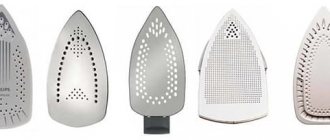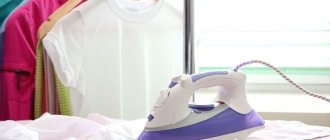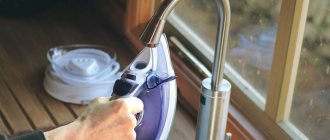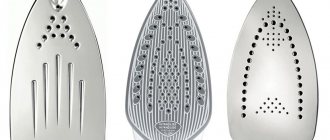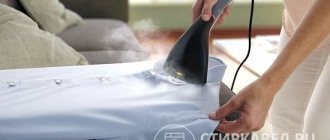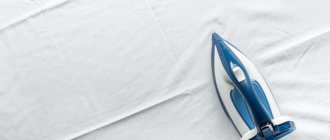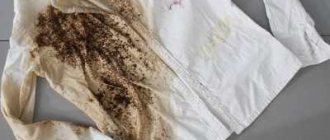Even owners of expensive household appliances sooner or later face the need to clean the iron from burnt fabric. Failure to comply with the temperature conditions leads to the fact that the fibers stick to the sole of the device and become charred. If you iron things with this iron in the future, brown spots will remain on the surface of your clothes and linen.
Types of coatings
When choosing a product to remove burnt fabric, you need to consider the coating material. The following types of iron soles are widely available:
- stainless steel;
- aluminum;
- ceramic;
- Teflon.
The first two types of soles are metal. To rid the surface of burnt surfaces, cleaning agents with hard particles - abrasives - are used. Do not use acids and acetone, as these substances can react with metal.
Ceramic and Teflon soles require delicate handling. After cleaning with abrasives, scratches remain on the iron, attracting small fibers of the fabric. As a result, the device sticks to clothes and linen even more strongly than before. You can wipe off carbon deposits using a special pencil or liquid solutions.
Paraffin candle
An ordinary candle will help to effectively clean the iron. It can easily cope with light stains and help remove plaque of any origin.
The candle should be wrapped in thick cotton cloth. This will be the pencil that... The iron must be heated, then gently run the candle along the sole. The handmade pencil will begin to melt and paraffin, flowing down the sole, will remove dirt.
When manipulating, you should maintain a slight angle of inclination so that the cleaning composition flows onto a previously prepared rag. After work, the sole should be cleaned with a hard, damp cloth.
If the unit is equipped with a steam function, it is necessary to clean the holes on the soleplate. To do this, pour water into the tank and use the steam boost several times. This will avoid the appearance of greasy wax stains on clothes that will be ironed in the future.
General rules for cleaning the iron from burnt fabric
Whatever coating you have to clean from stuck fabric, do not use sharp metal objects (knives, scissors, blades), stiff bristled brushes, or sandpaper. These materials leave scratches on the soleplate of the iron that cannot be sanded out later.
If you use solutions to clean the device, be sure to wipe the device with a damp cloth at the end. After the surface has dried, iron the cotton fabric. Do not leave the cleaner on the soles, otherwise it will later leave a greasy residue on your clothes.
To remove burnt tissue in the area of the holes, use cotton swabs soaked in vinegar (hydrogen peroxide, ammonia). Or wrap a piece of cotton wool around a toothpick.
Household chemicals
If the deposit is fresh, then you can remove it with regular soap. To do this, you need to wipe the sole with a small piece, and with a slightly damp lint-free cloth, carefully wash off all the dirt, which usually comes off easily and without leaving any traces. But it is no longer possible to remove old stains from the surface using this method; in this case, you can use solvent-based chemicals.
Old carbon deposits from fabric or polyethylene can be removed using any nail polish remover or other product with a weak solvent concentration. To clean, you need to moisten a small cotton swab or disk in the product, then carefully wipe the dirty area, gradually removing the burnt areas.
Attention! When choosing this method, the manufacturer's recommendations should be taken into account. Not all soles can be treated with solvents, but soap is suitable for everyone.
Cleaning irons with Teflon and ceramic coatings
There are many ways to remove stuck fabric from the soleplate of a modern iron, most of which are available at home. Let's look at the most reliable ones.
Cleaning Pencil
This product is suitable for cleaning burnt soles made of any material: metal, ceramics, Teflon. Removes old traces of burning. Sold in hardware and construction stores, on online platforms. The price varies between 15-150 rubles per piece.
The cleaning pencil does not contain abrasives, so it does not leave scratches on the soleplate of the iron or damage the heating elements. There are products that remove not only burnt fabric, but also traces of scale. The only drawback of the pencil is the strong smell during cleaning.
Examples of cleaning pencils:
- Frash – 90 rubles;
- Topperr IR 1 – 80 rubles;
- Bon – 70 rubles;
- Uniplus – 65 rubles;
- Magic Power – 55 rubles;
- Brite – 35 rubles;
- Snowter – 25 rubles.
The operating principle of all presented products is the same, so you can safely choose the most budget-friendly options.
How to use a cleaning pencil?
- Heat the device to the temperature specified in the instructions (usually 135-150 degrees).
- Tilt the iron 30 degrees. Rub with a pencil in places where burning has accumulated. The product will begin to melt, collect particles of adhering tissue and flow down. Do not press hard on the pencil, otherwise it will break abruptly and you will get burned.
- Let the device cool down. Remove any remaining pencil with a dry cloth.
- Use a stream of steam to remove any stuck-on fibers from the iron's holes.
- Iron the cotton fabric to secure the result.
We recommend: Is it possible to clean an iron with citric acid: 6 simple tips
Paraffin candle
This product is a home equivalent of a cleaning pencil. Suitable for removing only fresh traces of burnt fibers. The procedure is as follows.
- Wrap a long paraffin candle in cotton cloth.
- Plug in the iron and set the temperature to medium.
- Tilt the device and begin to move the candle along the surface of the sole.
- Wait until the iron cools down and then wipe it with a damp cloth.
Hydroperite tablets
You can buy them at the pharmacy. Hydroperite is a combination of hydrogen peroxide and urea, a substance found in cleaning pencils. The product emits a pungent odor, so we recommend scrubbing the iron while wearing a protective mask or on an open balcony.
How to use hydroperite tablets?
- Heat the iron to a temperature of 135-150 degrees, disconnect from the power source.
- Use an uncrushed tablet to wipe the surface with gentle movements, removing burnt marks.
- Wash off any remaining product with a damp cloth.
Acetone
The aggressive substance dissolves burning particles, so cleaning the sole later becomes easy. Paint thinner and nail polish remover are suitable for cleaning the device. Soak a rag in the liquid and wipe away the stains. The iron is turned off. Finally, remove any remaining product with a damp cloth.
When using liquids with acetone, make sure that they do not come into contact with plastic surfaces. This may damage the device.
Soap solution
If little burning has stuck, wash the soleplate of the iron in the usual way. The rag is moistened in one of the following solutions:
- liquid soap;
- dishwashing detergents;
- shower gel;
- shampoo.
Then wipe the device. To enhance the effect, apply pure liquid soap to the soleplate of the iron and leave for 30 minutes. Then rinse off the product with water and wipe the surface with a dry cloth.
Vinegar, citric acid
Every housewife has these liquids in her house. If the fabric is burnt on the iron, wipe its surface with a swab dipped in vinegar or citric acid solution (2 sachets per glass of water). Rinse off the product with a damp cloth. By the way, cleaning the iron with citric acid will help not only deal with burnt soles, but also soften the scale inside the device. This method is suitable for removing fresh traces of burning and is used for preventive purposes. But there is a more radical method.
- Pour vinegar into a wide pan to a level of 1 centimeter.
- Heat the iron to medium temperature, then unplug.
- Place the device with the sole down in the tray with vinegar. Leave for 6-8 hours (overnight is possible).
- Remove any remaining burnt material with a sponge and wipe the iron with a damp cloth.
If you hate wasting a lot of vinegar, then use a cotton cloth soaked in the product instead of a tray. Carry out the procedure in a well-ventilated area, as the solution has a strong smell and irritates the mucous membranes of the eyes and respiratory tract.
Hydrogen peroxide (3%) and ammonia
You may have these items in your first aid kit. You can wipe off stuck fabric using hydrogen peroxide or ammonia in the following ways.
- Soak a waffle towel in the solution, spread it on the board and iron it thoroughly until traces of burning are completely removed from the device.
- Heat the iron slightly and then unplug it. Wipe stains from stuck fabric with a cloth soaked in hydrogen peroxide or ammonia. Use cotton swabs to clean the holes.
We recommend: Why is it forbidden to pour distilled water into an iron with a steamer?
When working with ammonia, keep in mind that its vapors are harmful to the respiratory system. It is advisable to wear a respiratory mask or at least open all the windows in the room. Never wipe a hot iron with hydrogen peroxide or ammonia.
Dairy products
Before you try to remove iron stains from clothes at home, find out what the item is made of. Different types of fabric will require different tools.
It is best to first try to remove the stain with products prepared according to folk recipes. If they fail to remove the stain, then turn to household chemicals for help or take the item to the dry cleaner.
You can remove the greasy shine left from the iron from linen products using fermented milk products. Sour milk and kefir work great:
- Take a small basin or deep container.
- In a container, mix kefir or sour milk in equal parts.
- Immerse the item with a burn mark or yellow shine into the prepared cleaning solution.
- We leave the product to soak for 8-9 hours.
- We wash the item in a washing machine or by hand in regular powder. Rinse thoroughly to remove any remaining dairy products from the fabric.
- Dry the item in a well-ventilated place.
Cleaning irons with metal coating
This is where products containing abrasives will come to your aid. You can clean the surface of the iron with a dry cloth or an old toothbrush with soft bristles.
Salt
This product is always present in the kitchen. There are two ways to clean your iron with salt.
Lay a cotton cloth on the ironing board. Pour 0.5 cups of fine salt onto it and spread the grains over the surface in an even layer. Turn on the device, set the temperature to medium. Start stroking the salt and continue until the grains turn brown. Allow the iron to cool and then wipe with a dry cloth.
The second method requires caution, as there is a risk of getting burned. Pour some salt into gauze or a handkerchief and form a bag. Plug in the device. Once it's hot, start rubbing the soleplate in a circular motion until the burnt-on tissue comes off completely.
Do not use salt to clean aluminum irons, as the particles are quite large and can damage the coating (aluminum is a soft metal).
Baking soda
The principle of baking soda for removing stuck tissue is similar to table salt. Fine abrasives remove dirt from the surface and absorb it. Baking soda removes even old burnt stains.
The procedure is as follows:
- Pour 2 tablespoons of baking soda into a cup. Add a little water to make a smooth paste.
- Apply the product to the cold soleplate of the iron and rub with the hard side of a kitchen sponge.
- Remove any residue with a damp cloth.
Toothpaste or powder
Another product that is easy to use. Follow these steps:
- Apply the powder or paste to the cold soleplate of the iron, spread evenly over the entire surface, trying to avoid getting into the holes.
- Try scrubbing off burn marks with a toothbrush.
- Rinse off any remaining product with a damp cloth.
- Turn on the steam flow on the device.
- Iron the cotton fabric several times until no streaks remain on the soleplate of the iron.
Onion juice
An effective and cheap way to remove iron stains from any type of fabric (both synthetic and natural) is to use onions:
- Cut a medium onion in half.
- Using the cut side, rub the dirt remaining on the fabric after ironing.
- Leave the cloth for 5-10 minutes.
- After this, wash the product as usual and rinse well to get rid of the unpleasant onion smell.
IMPORTANT! You can also use onion pulp on synthetics and denim. Grind the onion to a liquid pulp, apply the mixture to the iron stain and leave for several hours. Then soak the item in cold water and wash as usual at a temperature of 30-40 degrees. This method works well to remove shine from iron on trousers.
Preventing the formation of burning marks
To prevent the household appliance from having to be frequently scrubbed with chemical pencils, solutions or abrasives, simply do not allow burnt fabric to appear on it. Even non-stick irons require maintenance. Frequent cleaning, even using proven methods, shortens its useful life.
Helpful tips for preventing burn marks:
- read the instructions on clothing labels and observe temperature conditions;
- Iron woolen and synthetic items not directly, but through a layer of gauze or thin cotton fabric;
- When the iron has cooled down, wipe it with a dry cloth each time.
How to avoid carbon deposits?
- linen - iron at a temperature of 180-200 ⁰C, after turning the product inside out;
- cotton - work at a temperature of 180 ⁰C, moisturizing the fabric in the process;
- polyester - sole temperature - up to 110 ⁰С, smooth out various patterns, embroideries on clothes only through gauze or from the wrong side;
- silk - temperature range 60-80 ⁰С, without using the steam function, iron the material through any thin fabric (except gauze);
- wool - heat the electrical appliance to 120 ⁰C, work the iron over the surface of the product through a moistened cotton cloth;
- viscose - iron things only from the inside out, without steam and humidification at a temperature of 110-120 ⁰C;
- chintz - the temperature regime for chintz fabric is 150-170 ⁰С, iron clothes on the front side.
ATTENTION! Many items are made from fabrics that are not advisable to iron - keep terry robes, towels, and nylon clothes flattened while drying.
Removing carbon stains from an iron using homemade or special products is not particularly difficult if you choose a method of removing dirt that is suitable for the type of soleplate of your device. The key to perfect cleanliness of the ironing element is compliance with the operating rules of the electrical device and the correct temperature conditions for ironing.
